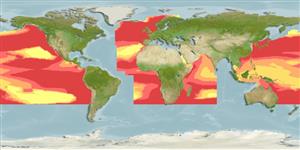Teleostei (teleosts) >
Scombriformes (Mackerels) >
Bramidae (Pomfrets)
Etymology: Taractes: Greek, taraktes = confusion; for the pletora of names that have been applied to this fish (Ref. 45335).
More on author: Lowe.
Environment: milieu / climate zone / depth range / distribution range
Ecology
Marine; pelagic-oceanic; oceanodromous (Ref. 51243); depth range 1 - 140 m (Ref. 58302). Temperate; 72°N - 35°S, 180°W - 180°E
Circumglobal: In tropical to temperate waters. Western Pacific: Japan (Ref. 559). Eastern Pacific: Alaska to southern California, USA. Eastern Atlantic: Madeira to Iceland and northern Norway (Ref. 6697); Cape Province, South Africa (Ref. 4388). Western Indian Ocean: southern Madagascar and Natal, South Africa (Ref. 4388); Maldives (Ref. 30829). Highly migratory species.
Size / Weight / Age
Maturity: Lm ? range ? - ? cm
Max length : 50.0 cm SL male/unsexed; (Ref. 6697)
Occurs offshore in warm and temperate waters (Ref. 6697). May spawn widely in the subtropics (Ref. 6697).
Life cycle and mating behavior
Maturity | Reproduction | Spawning | Eggs | Fecundity | Larvae
Smith, M.M., 1986. Bramidae. p. 633-636. In M.M. Smith and P.C. Heemstra (eds.) Smiths' sea fishes. Springer-Verlag, Berlin. (Ref. 4388)
IUCN Red List Status (Ref. 130435)
Threat to humans
Harmless
Human uses
More information
Common namesSynonymsMetabolismPredatorsEcotoxicologyReproductionMaturitySpawningSpawning aggregationFecundityEggsEgg development
ReferencesAquacultureAquaculture profileStrainsGeneticsElectrophoresesHeritabilityDiseasesProcessingNutrientsMass conversion
Tools
Special reports
Download XML
Internet sources
Estimates based on models
Preferred temperature (Ref.
123201): 6.7 - 27.9, mean 16 °C (based on 2326 cells).
Phylogenetic diversity index (Ref.
82804): PD
50 = 0.7500 [Uniqueness, from 0.5 = low to 2.0 = high].
Bayesian length-weight: a=0.01122 (0.00514 - 0.02450), b=3.04 (2.87 - 3.21), in cm total length, based on all LWR estimates for this body shape (Ref.
93245).
Trophic level (Ref.
69278): 4.2 ±0.6 se; based on size and trophs of closest relatives
Resilience (Ref.
120179): Medium, minimum population doubling time 1.4 - 4.4 years (Preliminary K or Fecundity.).
Fishing Vulnerability (Ref.
59153): Moderate vulnerability (44 of 100).
